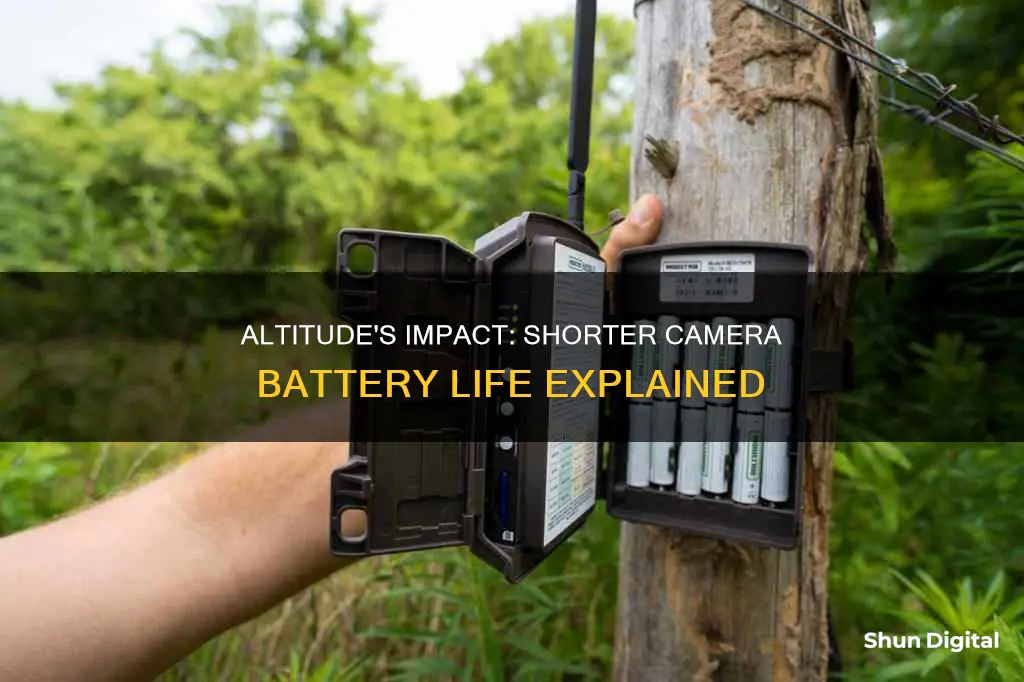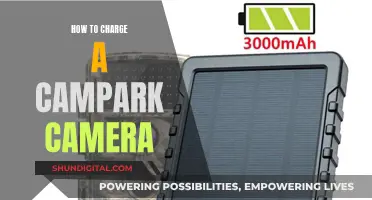
Camera batteries are affected by a variety of factors, including the device's settings, usage, and environmental conditions. One critical environmental factor is altitude, which can significantly impact battery performance. At higher altitudes, the thinner atmosphere and colder temperatures contribute to faster battery drainage. This effect has been observed by mountaineers, who have reported a significant reduction in battery capacity for cameras, phones, and other electronic devices. The decrease in performance is primarily attributed to the slower movement of ions between the terminals in colder temperatures. Additionally, the rarefied atmosphere at higher altitudes can lead to faster arcing, resulting in greater energy consumption. As a result, understanding the influence of altitude is crucial for photographers, adventurers, and anyone relying on camera equipment in high-altitude environments.
What You'll Learn

Cold temperatures cause ions to move slower between terminals
Cold temperatures have a significant impact on battery performance, and this is especially noticeable at high altitudes. When the temperature drops, the chemical reactions inside a battery slow down, causing ions to move more slowly between the terminals. This results in reduced battery capacity, which can be as much as a 50% decrease, as reported by mountaineers.
The effect of cold on batteries is a well-known issue, and it's why many people recommend keeping your camera battery warm, perhaps even "snuggling up to it", to ensure it continues to function optimally. However, it's important to avoid anything metallic that could cause a short circuit.
The issue of cold temperatures slowing down the movement of ions is not unique to camera batteries. All batteries are susceptible to this issue, which is why NASA uses radioactive isotopes to power rovers on Mars, where temperatures are extremely low.
Additionally, it's worth noting that while cold temperatures can decrease battery performance, extreme heat can also negatively affect batteries. Both extremes can cause problems, so it's important to try to maintain a moderate temperature for optimal battery life.
To summarise, cold temperatures are the primary reason why camera batteries expire faster at high altitudes, as the ions within the battery move more slowly, reducing the overall capacity and performance of the battery.
Outdoor Camera Options: Battery-Powered Security Solutions
You may want to see also

Greater energy consumption at higher altitudes
The thinner atmosphere at higher altitudes affects the speed at which electricity can flow between two points through the air, producing a phenomenon known as "arcing". This results in faster arcing and, consequently, greater energy consumption. Engineers take advantage of this phenomenon by placing communication towers on mountains to increase transmission range.
Altitude is not the only factor that influences battery life. Batteries are also affected by the mode of operation, with video recording and photo capture having different impacts on battery life. The settings on a camera, such as resolution and special features, can also affect battery consumption. For example, higher-resolution photos and features like glare reduction may deplete the battery more quickly.
Additionally, environmental factors, such as temperature, play a significant role. Extreme temperatures, both hot and cold, can impact battery performance. In particular, cold temperatures cause ions to move more slowly between the terminals, reducing battery efficiency. This is why batteries tend to drain faster in cold environments.
To prolong battery life, it is recommended to avoid extreme temperatures, especially the cold, and to consider using higher-quality batteries, such as lithium ones, which are more resistant to harsh conditions.
Is Your Camera Battery Charged? Check This Way
You may want to see also

Extreme heat also affects battery performance
Extreme Heat and Camera Batteries
Lithium batteries are a better choice in freezing temperatures, but they will only operate for a fraction of the time they would in milder climates. In other words, they will expire faster in extreme cold.
To preserve battery life, avoid placing the camera in extreme temperatures, especially the cold. If you're in a cold environment, snuggling up to your camera battery can help—just make sure there's nothing metallic nearby that could cause a short circuit.
Camtrix Camera Battery: How Long Does It Really Last?
You may want to see also

Lithium batteries are better in freezing temperatures
While batteries are affected by both high altitudes and freezing temperatures, lithium batteries are better suited to cold environments than other types of batteries.
Lithium-ion batteries are commonly used by NASA for their compact size, lightweight, and high energy density. They are also used in many consumer electronics, such as cameras, phones, and laptops. These devices are often used in high-altitude environments, such as mountains, where the air pressure and temperature are lower.
At high altitudes, the cold causes ions to shuttle more slowly between the terminals, reducing the battery's capacity. This can result in a significant drop in performance, with some mountaineers reporting up to a 50% decrease in their devices' battery life.
However, lithium-ion batteries perform much better in colder temperatures compared to other types of batteries, such as lead-acid batteries. While a lead-acid battery's capacity is reduced by up to 50% at 0°C, a lithium-ion battery only loses about 10% of its capacity at the same temperature. This makes lithium-ion batteries ideal for use in cold environments, such as in RVs, off-grid solar power systems, and electric vehicles.
It is important to note that while lithium-ion batteries can operate in a wide range of temperatures, charging them in freezing temperatures can cause permanent damage. This is because the lithium ions do not efficiently bind to the anode (the negative terminal) at temperatures below freezing, leading to a process called lithium plating, which reduces the battery's capacity and stability. Therefore, it is recommended to only charge lithium-ion batteries at temperatures above 0°C to prevent irreversible damage.
To safely use lithium-ion batteries in freezing temperatures, some manufacturers have developed innovative solutions. For example, RELiON has created a lithium iron phosphate battery that can be safely charged at temperatures as low as -20°C. This battery features a built-in heating system that automatically warms the cells to an optimal temperature before charging, ensuring safe and efficient use in extremely cold environments.
Identifying Camera Batteries: A Quick Guide
You may want to see also

Alkaline batteries are cheaper but less resistant to the cold
Alkaline batteries are a common choice for powering devices due to their affordability and convenience. However, they are less suitable for cold environments, and their performance rapidly declines at low temperatures. This is because they contain a water-based electrolyte, which freezes when the temperature drops below zero. As a result, the chemical reactions that generate power are significantly slowed down, leading to reduced battery performance and runtime.
In contrast, lithium batteries, which are more expensive, utilise a non-aqueous electrolyte and are therefore less susceptible to the cold. They can operate effectively at temperatures as low as -40°F (-40°C), making them ideal for cold environments. While rechargeable batteries are advantageous in many situations, they are not the best option in cold conditions, as they too contain water-based electrolytes that hinder their performance in freezing temperatures.
The impact of cold on alkaline batteries is a crucial consideration for anyone using battery-powered devices in cold environments, such as high altitudes or cold climates. The performance of alkaline batteries can be improved in such conditions by keeping the batteries warm, such as by storing them in a pocket or case. However, it is essential to avoid metallic objects that could cause a short circuit.
When choosing batteries for cold environments, it is essential to consider the specific temperature range and the power requirements of the devices. While lithium batteries offer superior performance in the cold, they may not be necessary for all situations. For example, in moderate climates, alkaline batteries can still provide sufficient power, especially for low-to-moderate drain devices. Additionally, the higher cost of lithium batteries may be a factor in the decision-making process.
In summary, while alkaline batteries are a cost-effective and widely available option, they are less resistant to cold temperatures due to the presence of water-based electrolytes. For cold environments, lithium batteries are a more suitable choice, offering stable performance even at extremely low temperatures. However, for those operating on a budget or in moderate climates, alkaline batteries can still be a viable option, especially with proper care and storage.
Replacing Li-ion Camera Batteries: A Step-by-Step Guide
You may want to see also
Frequently asked questions
Yes, high altitudes can impact the performance and lifespan of camera batteries. This is due to various factors, including temperature extremes and changes in atmospheric pressure.
The thin air at high altitudes can cause the battery to work harder, especially if it is frequently triggered. Additionally, cold temperatures can slow down the chemical reactions within the battery, reducing its power output.
Lithium batteries are generally recommended for high-altitude use due to their lightweight properties and ability to perform well in extreme weather conditions. They tend to have a longer lifespan and are less susceptible to cold temperatures than other battery types.
To extend battery life at high altitudes, consider the following:
- Reduce resolution: Lowering the resolution setting can decrease power consumption without sacrificing too much image quality.
- Manage upload frequency: Adjusting the camera to upload media at specified intervals instead of in real-time can conserve power.
- Minimize trigger sensitivity: Reducing the sensitivity of the motion detection feature can prevent unnecessary activations, thus saving battery life.
- Use external power sources: Adding additional batteries or solar panels can significantly increase the operational life of your camera.
Rechargeable NiMH batteries may not be ideal for high-altitude use, especially in cold weather. They can lose charge rapidly and their voltage can fluctuate, leading to unreliable camera operation. It is recommended to use high-quality lithium batteries for consistent performance and longer lifespan in extreme environments.







